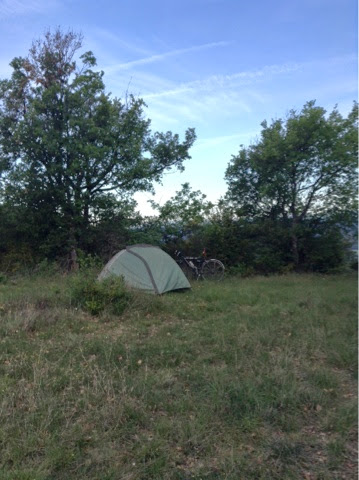The four-story museum in a building that dates to the 1600s and was originally a hospital until it was converted to a museum in 1905 devotes two rooms to Goldsworthy and features a fifty-meter long canvas of clay on the wall in another room--a large gallery mostly of landscape paintings. It is entitled "River of Earth" and was commissioned in 1999.
I felt strangely bereft to be in an art museum without Janina for the first time in two years, greatly missing her and her passionate and scholarly commentary on every work and painting on display, or at least those she did not dismiss as being unworthy of attention. And how could I dispute the highly-honed opinion of an art professor/critic/artist. At times she can become so possessed waving her arms and swooping in on a painting pointing out its every intimate feature, a security guard will rush over, fearful she is about to put flesh to the merchandise.
She would have been dancing with delight in the presence of "River of Earth" as it had a dance theme to it and dance is another of her passions. She has always had an affinity for Goldsworthy, and me too, with our shared love for the outdoors and the natural. Her lush, forested backyard is home to a couple of Goldsworthy-inspired works of her own--a totem of rocks and a long fence of tree limbs. This past January we had seen one of Goldsworthy's latest works at the St. Louis Museum of Art--twenty-five overlapping ten-foot arches of limestone. This "Stone Sea" resides in an enclosed subterranean courtyard between the museum's original 1904 building and its addition opened last year. It was as breathtaking as any of his works and easily one of the most substantial. His work also includes such ephemeral constructions as leaves in formation drifting down streams and concoctions of twigs left to the mercy of the wind and moldings of ice that will melt away. Many of them can be seen in the superlative documentary from 2001 "Rivers and Tides."
In one of the videos at the museum showing Goldsworthy's latest project in the region, "Refuge d'Art," reconstructing centuries old stone chapels and farm houses for hikers to use as overnight abodes, he says he has been drawn to the region by its strong sense of geological movement. The flow of rivers along with rock and stone are central to his vision. "Roads take you through places, rivers lead you in," he explained. He tries to find the river in the stones he works with, their line of energy. In each of the handful of refuges that he has so far rebuilt, he includes a work of art inside. The refuges are scattered over a one hundred mile loop on old paths through the mountainous terrain. They are spaced so that one can hike the route in ten days with an overnight repose at his places without charge. They are kept locked, but a key is provided to them at the Gassandi Museum.
Another one of the many great treasures of France that Goldsworthy most certainly has spent time at is just thirty miles south of Digne--the Grand Canyon du Verdon. It is more of a gash than a canyon, but there is no denying its grandness.
A road hugs the cliffside all around it. I took the southerly route, climbing 2,400 feet from the road that crosses the Verdon River at its mouth overlooking a vast dam-created turquoise lake. The road continues for twenty-five miles on each side.
I'd had another perfect campsite the night before on a plateau preceding the canyon. The canyon was surrounded by so many private campsites, a sign forbade wild camping. I always take such signs to imply that one is welcome to wild camp elsewhere.
I found a little nook for my tent beyond a pasture of lavender.
The neat rows of lavender stretched for miles to the south.
And to the north were the snow dappled Alps.
There is an unimaginable amount of pristine landscape all over France. Beyond the canyon on the road south was a roguh wilderness and home to a military base with signs forbidding leaving the road. I am regularly asked to recommend a place to cycle in France. It is all splendid, but I was continually marveling ever since I left Grenoble that the views and the cycling over this couple hundred mile stretch were as good as any.
I had a fabulous campsite too just before Digne. I ducked into a large field of recently cut wheat knowing I could disappear into any of the trees surrounding it.
I settled upon a sandy embankment in a dried up riverbed.
Unlike the Philippines where I had to worry every day about finding a place to sleep, in France I look forward every night to another delux, four-star campsite. It is truly a cyclist's paradise.











1 comment:
G'Day George,
Our paths have converged again - we were in the area last Autumn.
In addition to well tolerated free camping France offers free roadside food. Most amenable in autumn as grapes, walnuts, chestnuts (avoid the horse chestnut), figs, persimmons, cherimoya etc.
The spring roadside offering is edible green weeds. Nutritious but not the bulk carbohydrate a cyclist needs. Some spring mushrooms are edible raw and some kill.
Watch for and be guided by experienced local roadside foragers?
Post a Comment